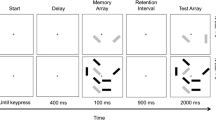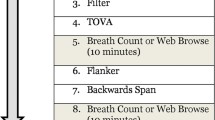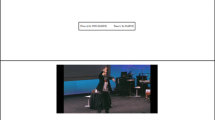Abstract
In a series of four studies, self-reported media multitasking (using the media multitasking index; MMI) and general sustained-attention ability, through performance on three sustained-attention tasks: the metronome response task (MRT), the sustained-attention-to-response task (SART), and a vigilance task (here, a modified version of the SART). In Study 1, we found that higher reports of media multitasking were associated with increased response variability (i.e., poor performance) on the MRT. However, in Study 2, no association between reported media multitasking and performance on the SART was observed. These findings were replicated in Studies 3a and 3b, in which we again assessed the relation between media multitasking and performance on both the MRT and SART in two large online samples. Finally, in Study 4, using a large online sample, we tested whether media multitasking was associated with performance on a vigilance task. Although standard vigilance decrements were observed in both sensitivity (A') and response times, media multitasking was not associated with the size of these decrements, nor was media multitasking associated with overall performance, in terms of either sensitivity or response times. Taken together, the results of the studies reported here failed to demonstrate a relation between habitual engagement in media multitasking in everyday life and a general deficit in sustained-attention processes.









Similar content being viewed by others
Notes
Replicating a previous finding (Seli, Cheyne, & Smilek, 2013), paired-samples t tests confirmed that the transformed RRT variance was significantly higher for the five trials preceding reports of mind wandering (M = 8.21, SD = 0.88) than for the five trials preceding reports of being on task (M = 7.92, SD = 0.82), t(66) = 3.35, SE = 0.09, p = .001.
As in a previous report (Seli et al., 2014), the transformed mean movement was nominally higher on the five trials preceding reports of mind wandering (M = 4.12, SD = 0.57) than on the five trials preceding reports of being on task (M = 4.04, SD = 0.58). However, unlike in the previous report, the difference found here did not reach significance using a two-tailed paired-sample t test, t(66) = 1.38, SE = 0.61, p = .17.
Given that we found no relation between media multitasking and these two measures, we opted not to include them in subsequent studies.
We also examined the relation between scores on the MMI and variance of go RTs, computed along the same lines as that of Study 1; that is, using the natural logarithm transformed variability of a moving five-trial window. No significant correlation was observed between the windowed RT variance (M = 8.08, SD = 0.76) and MMI scores, r(74) = .13, p = .27.
No significant correlation was observed between the windowed RT variance (M = 7.83, SD = 0.67) and MMI scores, r(124) = –.09, p = .32.
MMI scores for this sub-group of 20 participants had a mean of 2.46 and a standard deviation of 1.34. Whereas in Studies 3a and 3b we analyzed data with and without these participants included, in Study 4 we simply decided to exclude them on the basis of violating the premise of the task.
This pattern of significance remained true following the removal of outliers who were more than three standard deviations above or below the means of the variables of interest: A' slopes remained nonsignificantly correlated with MMI scores, r(102) = –.07, p = .49, and RT slopes remained nonsignificantly correlated with MMI scores, r(103) = .11, p = .25.
References
Alzahabi, R., & Becker, M. W. (2013). The association between media multitasking, task-switching, and dual-task performance. Journal of Experimental Psychology: Human Perception and Performance, 39, 1485–1495. doi:10.1037/a0031208
Cain, M. S., & Mitroff, S. R. (2011). Distractor filtering in media multitaskers. Perception, 40, 1183–1192. doi:10.1068/p7017
Carriere, J. S. A., Seli, P., & Smilek, D. (2013). Wandering in both mind and body: Individual differences in mind wandering and inattention predict fidgeting. Canadian Journal of Experimental Psychology, 67, 19–31. doi:10.1037/a0031438
Carter, L., Russell, P. N., & Helton, W. S. (2013). Target predictability, sustained attention, and response inhibition. Brain and Cognition, 82, 35–42. doi:10.1016/j.bandc.2013.02.002
Cheyne, J. A., Carriere, J. S. A., & Smilek, D. (2006). Absent-mindedness: Lapses of conscious awareness and everyday cognitive failures. Consciousness and Cognition, 15, 578–592. doi:10.1016/j.concog.2005.11.009
Giambra, L. M. (1989). Task-unrelated-thought frequency as a function of age: A laboratory study. Psychology and Aging, 4, 136–143.
Giambra, L. M. (1995). A laboratory method for investigating influences on switching attention to task-unrelated imagery and thought. Consciousness and Cognition, 4, 1–21. doi:10.1006/ccog.1995.1001
Hancock, P. A. (2013). In search of vigilance: The problem of iatrogenically created psychological phenomena. American Psychologist, 68, 97–109. doi:10.1037/a0030214
Helton, W. S., & Russell, P. N. (2012). Brief mental breaks and content-free cues may not keep you focused. Experimental Brain Research, 219, 37–46. doi:10.1007/s00221-012-3065-0
Jonker, T. R., Seli, P., Cheyne, J. A., & Smilek, D. (2013). Performance reactivity in a continuous-performance task: Implications for understanding post-error behavior. Consciousness and Cognition, 22, 1468–1476. doi:10.1016/j.concog.2013.10.005
Mackworth, J. F. (1964). Performance decrement in vigilance, threshold, and high-speed perceptual motor tasks. Canadian Journal of Psychology, 18, 209–223. doi:10.1037/h0083302
Mackworth, N. H. (1948). The breakdown of vigilance during prolonged visual search. Quarterly Journal of Experimental Psychology, 1, 6–21. doi:10.1080/17470214808416738
Mackworth, N. H. (1950). Researches on the measurement of human performance (Medical Research Council, Special Report No. 268). London: Medical Research Council.
Macmillan, N. A., & Creelman, C. D. (2005). Detection theory: A user’s guide (2nd ed.). Mahwah: Erlbaum.
McCormack, P. D. (1958). Performance in a vigilance task as a function of length of inter-stimulus interval and interpolated rest. Canadian Journal of Psychology, 12, 242–246. doi:10.1037/h0083749
McVay, J. C., & Kane, M. J. (2012). Drifting from slow to “d’oh!”: Working memory capacity and mind wandering predict extreme reaction times and executive control errors. Journal of Experimental Psychology: Learning, Memory, and Cognition, 38, 525–549. doi:10.1037/a0025896
McVay, J. C., Meier, M. E., Touron, D. R., & Kane, M. J. (2013). Aging ebbs the flow of thought: Adult age differences in mind wandering, executive control, and self-evaluation. Acta Psychologica, 142, 136–147. doi:10.1016/j.actpsy.2012.11.006
Minear, M., Brasher, F., McCurdy, M., Lewis, J., & Younggren, A. (2013). Working memory, fluid intelligence, and impulsiveness in heavy media multitaskers. Psychonomic Bulletin & Review, 20, 1274–1281. doi:10.3758/s13423-013-0456-6
Ophir, E., Nass, C., & Wagner, A. D. (2009). Cognitive control in media multitaskers. Proceedings of the National Academy of Sciences, 106, 15583–15587. doi:10.1073/pnas.0903620106
Paolacci, G., Chandler, J., & Ipeirotis, P. G. (2010). Running experiments on Amazon Mechanical Turk. Judgement and Decision Making, 5, 411–419.
Ralph, B. C. W., Thomson, D. R., Cheyne, J. A., & Smilek, D. (2014). Media multitasking and failures of attention in everyday life. Psychological Research, 78, 661–669. doi:10.1007/s00426-013-0523-7
Rideout, V. J., Foehr, U. G., & Roberts, D. F. (2010). Generations M 2 : Media in the lives of 8- to 18-year-olds (Technical Report). Menlo Park: Henry J. Kaiser Family Foundation.
Riva, G., Teruzzi, T., & Anolli, L. (2003). The use of the internet in psychological research: Comparison of online and offline questionnaires. Cyberpsychology & Behavior, 6, 73–80.
Robertson, I. H., Manly, T., Andrade, J., Baddeley, B. T., & Yiend, J. (1997). “Oops!”: Performance correlates of everyday attentional failures in traumatic brain injured and normal subjects. Neuropsychologia, 35, 747–758. doi:10.1016/S0028-3932(97)00015-8
Seli, P., Carriere, J. S. A., Thomson, D. R., Cheyne, J. A., Ehgoetz Martens, K. A., & Smilek, D. (2014). Restless mind, restless body. Journal of Experimental Psychology: Learning, Memory, and Cognition, 40, 660–668. doi:10.1037/a0035260
Seli, P., Cheyne, J. A., Barton, K. R., & Smilek, D. (2012a). Consistency of sustained attention across modalities: Comparing visual and auditory versions of the SART. Canadian Journal of Experimental Psychology, 66, 44–50. doi:10.1037/a0025111
Seli, P., Cheyne, J. A., & Smilek, D. (2012b). Attention failures versus misplaced diligence: Separating attention lapses from speed–accuracy trade-offs. Consciousness and Cognition, 21, 277–291. doi:10.1016/j.concog.2011.09.017
Seli, P., Cheyne, J. A., & Smilek, D. (2013a). Wandering minds and wavering rhythms: Linking mind wandering and behavioral variability. Journal of Experimental Psychology: Human Perception and Performance, 39, 1–5. doi:10.1037/a0030954
Seli, P., Jonker, T. R., Cheyne, J. A., & Smilek, D. (2013b). Enhanced SART validity by statistically controlling speed–accuracy trade-offs. Frontiers in Psychology, 4, 265. doi:10.3389/fpsyg.2013.00265
Seli, P., Jonker, T. R., Solman, G. J. F., Cheyne, J. A., & Smilek, D. (2013c). A methodological note on evaluating performance in a sustained-attention-to-response task. Behavior Research Methods, 45, 355–363. doi:10.3758/s13428-012-0266-1
Smallwood, J., Beach, E., Schooler, J. W., & Handy, T. C. (2008). Going AWOL in the brain: Mind wandering reduces cortical analysis of external events. Journal of Cognitive Neuroscience, 20, 458–469. doi:10.1162/jocn.2008.20037
Smallwood, J., McSpadden, M., & Schooler, J. W. (2007). The lights are on but no one’s home: Meta-awareness and the decoupling of attention when the mind wanders. Psychonomic Bulletin & Review, 14, 527–533.
Smilek, D., Carriere, J. S. A., & Cheyne, J. A. (2010). Failures of sustained attention in life, lab, and brain: Ecological validity of the SART. Neuropsychologia, 48, 2564–2570. doi:10.1016/j.neuropsychologia.2010.05.002
Author information
Authors and Affiliations
Corresponding author
Rights and permissions
About this article
Cite this article
Ralph, B.C.W., Thomson, D.R., Seli, P. et al. Media multitasking and behavioral measures of sustained attention. Atten Percept Psychophys 77, 390–401 (2015). https://doi.org/10.3758/s13414-014-0771-7
Published:
Issue Date:
DOI: https://doi.org/10.3758/s13414-014-0771-7




